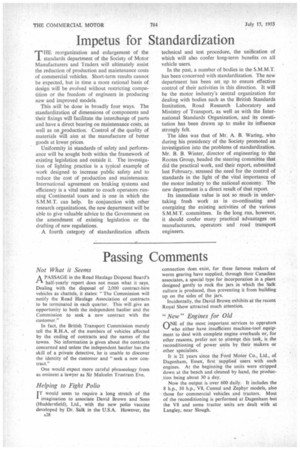Impetus for Standardization
Page 30

If you've noticed an error in this article please click here to report it so we can fix it.
rr HE reorganization and enlargement of the 1. standards department of the Society of Motor Manufacturers and Traders will ultimately assist the reduction of production and maintenance costs of commercial vehicles. Short-term results cannot be expected, but in time a more rational basis of design will be evolved without restricting competition or the freedom of engineers in producing new and improved models.
This will be done in broadly four ways. The standardization of dimensions of components and their fixings will facilitate the interchange of parts and have a direct bearing on maintenance costs, as well as on production. Control of the quality of materials will aim at the manufacture of better goods at lower prices.
Uniformity in standards of safety and performance will be sought both within the framework of existing legislation and outside it. The investigation of lighting practice is a typical example of work designed to increase public safety and to reduce the cost of production and maintenance. International agreement on braking systems and efficiency is a vital matter to coach operators running Continental tours and is one in which the S.M.M.T. can help. In conjunction with other research organizations, the new department will be able to give valuable advice to the Government on the amendment of existing legislation or the drafting of new regulations.
A fourth category of standardization affects technical and test procedure, the unification of which will also confer long-term benefits on all vehicle users.
In the past, a number of bodies in the S.M.M.T. has been concerned with standardization. The new department has been set_ up to ensure effective control of their activities in this direction. It will be the motor industry's central organization for dealing with bodies such as the British Standards Institution, Road Research Laboratory and Ministry of Transport, as well as with the International Standards Organization, and its constitution has been drawn up to make its influence strongly felt.
The idea was that of Mr. A. B. Waring, who during his presidency of the Society promoted an investigation into the problems of standardization. Mr. B. B. Winter, director of engineering to the Rootes Group, headed the steering committee that did the practical work, and their report, submitted last February, stressed the need for the control of standards in the light of the vital importance of the motor industry to the national economy. The new department is a direct result of that report.
Its immediate value is not so much in undertaking fresh work as in co-ordinating and energizing the existing activities of the various S.M.M.T. committees. In the long run, however, it should confer many practical advantages on manufacturers, operators and road transport engineers.




























































































